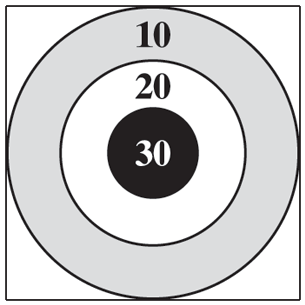
The accompanying dartboard is a square whose sides are of length 6: 
The three circles are all centered at the center of the board and are of radii 1, 2, and 3, respectively. Darts landing within the circle of radius I score 30 points, those landing outside this circle, but within the circle of radius 2, are worth 20 points, and those landing outside the circle of radius 2, but within the circle of radius 3, are worth 10 points. Darts that do not land within the circle of radius 3 do not score any points. Assuming that each dart that you throw will, independently of what occurred on your previous throws, land on a point uniformly distributed in the square, find the
a. You score 20 on a throw of the dart.
b. You score at least 20 on a throw of the dart.
c. You score 0 on a throw of the dart.
d. The
e. Both of your first two throws score at least 10.
f. Your total score after two throws is 30.
Want to see the full answer?
Check out a sample textbook solution
Chapter 6 Solutions
A First Course in Probability (10th Edition)
- 2) Suppose we select two values x and y independently from the uniform distribution on [0,1]. What is the probability that xyarrow_forward100 identical balls are rolling along a straight line. They all have speed equal to v, but some of them might move in opposite directions. When two of them collide they immediately switch their direction and keep the speed v. What is the maximum number of collisions that can happen? Let f(w) be a function of vector w Є RN, i.e. f(w) = 1+e Determine the first derivative and matrix of second derivatives off with respect to w. Let A Є RN*N be a symmetric, positive definite matrix and bЄ RN a vector. If x ER, evaluate the integral Z(A,b) = e¯xAx+bx dx as a function of A and b. John throws a fair die with faces labelled 1 to 6. ⚫ He gains 10 points if the die shows 1. ⚫ He gains 1 point if the die shows 2 or 4. • No points are allocated otherwise. Let X be the random variable describing John's gain at each throw. Determine the variance of X.arrow_forwardFemale Male Totals Less than High School Diploma 0.077 0.110 0.187 High School Diploma 0.154 0.201 0.355 Some College/University 0.141 0.129 0.270 College/University Graduate 0.092 0.096 0.188 Totals 0.464 0.536 1.000arrow_forwardFemale Male Totals Less than High School Diploma 0.077 0.110 0.187 High School Diploma 0.154 0.201 0.355 Some College/University 0.141 0.129 0.270 College/University Graduate 0.092 0.096 0.188 Totals 0.464 0.536 1.000arrow_forwardFemale Male Totals Less than High School Diploma 0.077 0.110 0.187 High School Diploma 0.154 0.201 0.355 Some College/University 0.141 0.129 0.270 College/University Graduate 0.092 0.096 0.188 Totals 0.464 0.536 1.000arrow_forwardFemale Male Totals Less than High School Diploma 0.077 0.110 0.187 High School Diploma 0.154 0.201 0.355 Some College/University 0.141 0.129 0.270 College/University Graduate 0.092 0.096 0.188 Totals 0.464 0.536 1.000arrow_forward6.54 Let Y₁, Y2,..., Y, be independent Poisson random variables with means 1, 2,..., An respectively. Find the a probability function of Y. b conditional probability function of Y₁, given that Y = m. Y₁ = m. c conditional probability function of Y₁+Y2, given that 6.55 Customers arrive at a department store checkout counter according to a Poisson distribution with a mean of 7 per hour. In a given two-hour period, what is the probability that 20 or more customers will arrive at the counter? 6.56 The length of time necessary to tune up a car is exponentially distributed with a mean of .5 hour. If two cars are waiting for a tune-up and the service times are independent, what is the probability that the total time for the two tune-ups will exceed 1.5 hours? [Hint: Recall the result of Example 6.12.] 6.57 Let Y, Y2,..., Y,, be independent random variables such that each Y, has a gamma distribution with parameters a, and B. That is, the distributions of the Y's might have different a's, but…arrow_forward6.82 6.83 6.84 6.85 *6.86 6.87 If Y is a continuous random variable and m is the median of the distribution, then m is such that P(Ym) = P(Y ≥ m) = 1/2. If Y₁, Y2,..., Y, are independent, exponentially dis- tributed random variables with mean ẞ and median m, Example 6.17 implies that Y(n) = max(Y₁, Y., Y) does not have an exponential distribution. Use the general form of FY() (y) to show that P(Y(n) > m) = 1 - (.5)". Refer to Exercise 6.82. If Y₁, Y2,..., Y,, is a random sample from any continuous distribution with mean m, what is P(Y(n) > m)? Refer to Exercise 6.26. The Weibull density function is given by -my" m-le-y/a f(y)= α 0. y > 0, elsewhere, where a and m are positive constants. If a random sample of size n is taken from a Weibull distributed population, find the distribution function and density function for Y(1) = min(Y1, Y2,Y). Does Y(1) = have a Weibull distribution? Let Y₁ and Y2 be independent and uniformly distributed over the interval (0, 1). Find P(2Y(1) 0, elsewhere,…arrow_forward6.26 The Weibull density function is given by e-y/a f(y) = α 0. y > 0, elsewhere, where a and m are positive constants. This density function is often used as a model for the lengths of life of physical systems. Suppose Y has the Weibull density just given. Find a the density function of UY". b E(Y) for any positive integer k. 6.27 Let Y have an exponential distribution with mean ẞ. 6.28 6.29 a Prove that W = √Y has a Weibull density with α = ẞ and m = 2. b Use the result in Exercise 6.26(b) to give E(Yk/2) for any positive integer k. Let Y have a uniform (0, 1) distribution. Show that U = -2ln(Y) has an exponential distri- bution with mean 2. The speed of a molecule in a uniform gas at equilibrium is a random variable V whose density function is given by 6.30 6.31 6.32 f(v) = av²e-by², v > 0, where b = m/2kT and k, T, and m denote Boltzmann's constant, the absolute temperature, and the mass of the molecule, respectively. a Derive the distribution of W = mV2/2, the kinetic energy of…arrow_forwardQIA Let F-4c24, countible or, A, countible), show that is o-algebra. B Let (Fne N) is family of a-algebra on 2, prove that F. o-algebra Q2: Prove that: 1. X, is martingale -esin 2. M, -e sin B,, is martingale by using Ito formula Q3: A Let X, has stochastic differential with drift p(x)=-bx + c, and diffusion o²(x)=4x, let Y√X,, where X, ≥0, find dr B: Let X, -(-s), Ito integral process, find dx, and [x.xko). Q4: Let Y, =[x,dB, is Ito integral, such that X, is nonrandom process, find: التوزيع 1. The distribution of Y 2. The moment generating function of Y,.arrow_forwardSolve the following Probability Problem (solve all parts) HW 2.x. (Headless Hunt)The Headless Hunt is an organization of 88 Hogwarts ghosts so elite thateven Nearly Headless Nick was annually denied admission for decades,despite being The Gryffindor ghost. The ghosts love playing sports anddecided to get together and have either a Head Polo tournament or aHorseback Head-Juggling tournament. However, even if they are ghosts,they still have jobs so some of them might have an urgent haunting as-signment. In order for no one to be left behind they need to be able tosplit into teams of equal numbers. Head polo teams consist of 4 playerswhereas Horseback Head-Juggling teams have 11 players. Assume thatany number of them from 1 to 88 show up with equal probability. a) What is the probability they will be able to play one of the twotournaments?b) If in addition to the previous 2 sports there was one more option, atournament in Headless bowling which is played in teams of 8 players,what would…arrow_forward42. Consider the following joint probability table. B₁ B2 B3 B4 A 0.09 0.22 0.15 0.20 A 0.03 0.10 0.09 0.12arrow_forwardarrow_back_iosSEE MORE QUESTIONSarrow_forward_ios
 Elementary Geometry For College Students, 7eGeometryISBN:9781337614085Author:Alexander, Daniel C.; Koeberlein, Geralyn M.Publisher:Cengage,
Elementary Geometry For College Students, 7eGeometryISBN:9781337614085Author:Alexander, Daniel C.; Koeberlein, Geralyn M.Publisher:Cengage, Trigonometry (MindTap Course List)TrigonometryISBN:9781305652224Author:Charles P. McKeague, Mark D. TurnerPublisher:Cengage Learning
Trigonometry (MindTap Course List)TrigonometryISBN:9781305652224Author:Charles P. McKeague, Mark D. TurnerPublisher:Cengage Learning Holt Mcdougal Larson Pre-algebra: Student Edition...AlgebraISBN:9780547587776Author:HOLT MCDOUGALPublisher:HOLT MCDOUGAL
Holt Mcdougal Larson Pre-algebra: Student Edition...AlgebraISBN:9780547587776Author:HOLT MCDOUGALPublisher:HOLT MCDOUGAL Mathematics For Machine TechnologyAdvanced MathISBN:9781337798310Author:Peterson, John.Publisher:Cengage Learning,
Mathematics For Machine TechnologyAdvanced MathISBN:9781337798310Author:Peterson, John.Publisher:Cengage Learning, Algebra: Structure And Method, Book 1AlgebraISBN:9780395977224Author:Richard G. Brown, Mary P. Dolciani, Robert H. Sorgenfrey, William L. ColePublisher:McDougal Littell
Algebra: Structure And Method, Book 1AlgebraISBN:9780395977224Author:Richard G. Brown, Mary P. Dolciani, Robert H. Sorgenfrey, William L. ColePublisher:McDougal Littell Elementary AlgebraAlgebraISBN:9780998625713Author:Lynn Marecek, MaryAnne Anthony-SmithPublisher:OpenStax - Rice University
Elementary AlgebraAlgebraISBN:9780998625713Author:Lynn Marecek, MaryAnne Anthony-SmithPublisher:OpenStax - Rice University





